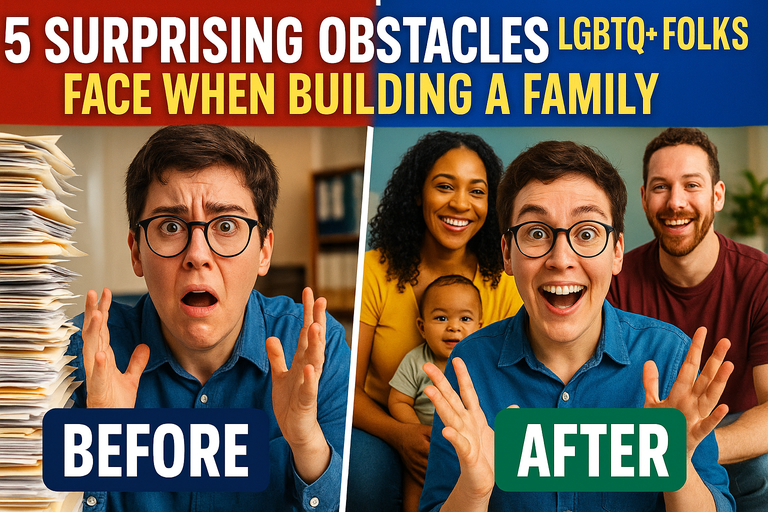5 Surprising Obstacles LGBTQ+ Folks Face When Building a Family (And How to Overcome Them at Home)
Posted on by James Anderson - LGBTQ+ Fertility Journeys
Did you think starting a family was just about picking baby names and painting nurseries? Think again.
I remember the day my partner and I sat at our kitchen table, equal parts nervous and excited, dreaming about becoming parents. We had the books, the vision board, and—let’s be honest—a lot of questions. What we didn’t expect was how many unseen hurdles were waiting for us, especially as members of the LGBTQ+ community.
This week, while scrolling through the news, I hit a gut-punch headline: "Transgender Veterans Barred From Fertility Treatment Under New Rules". If you missed it, here’s the quick version: The VA is cutting off coverage for cryopreservation for transgender veterans. That’s a fancy word for freezing eggs and sperm—the very first step some people take to preserve their shot at building a family.
Wait, what? In 2025, this is still a thing?
Let’s talk about the 5 obstacles nobody warns you about if you’re LGBTQ+—and how at-home options are rewriting the rules.
1. The System Wasn’t Built for Us (Literally)
If you’ve ever tried booking a fertility consult and had to check a box that didn’t describe you, you get it. Most traditional clinics assume a two-parent, cisgender couple, which means LGBTQ+ patients are often left explaining their situation again and again. Exhausting, right?
And when you add in the recent VA decision for transgender vets, it’s clear the system has some catching up to do. It’s not just a formality—it can be a giant roadblock, especially for folks who already have a complicated relationship with healthcare.
2. The “Price Tag Shock” is Real
Fertility treatments—think IVF, cryopreservation, or IUI—don’t just cost a lot; they really cost a lot. Most insurance plans don’t cover fertility care for LGBTQ+ families, and now, for some veterans, even the VA is pulling the rug out.
When you’re staring down bills for thousands of dollars for basic services, it can feel like the universe is saying, “Not for you.”
But here’s the twist: in the last few years, at-home insemination kits have shown up as game-changers. They offer a more affordable, private, and empowering way to try—without emptying your savings account.
3. Privacy Matters More Than Ever
News like the VA ruling can leave you feeling exposed—like your ability to build a family is some kind of hot topic for public debate. Sometimes, you just want to keep things intimate.
That’s why so many couples (and singles!) are turning to at-home options. I recently learned about all the ways MakeAMom supports privacy and discretion. Their insemination kits arrive in plain, unmarked packaging—honestly, it feels like stealth mode for your most personal journey.
4. Medical Gatekeeping and Emotional Burnout
Let’s be real: explaining your pronouns and relationship status to every new nurse or doctor is draining. It can feel like you’re constantly having to justify your family and your right to try. The VA’s new rule is just one of many ways the medical system can leave LGBTQ+ folks feeling unseen.
Home insemination is taking off partly because it lets you skip the awkward explanations, the waiting room stares, and the feeling of being “othered.” More people are sharing their stories online, and the common thread? Relief at finally being in control.
5. Fertility Isn’t “One Size Fits All”
Whether you’re working with low sperm motility, have sensitivities like vaginismus, or are using frozen sperm, everyone’s journey is unique. The old-school, one-size-fits-all approach just doesn’t cut it. That’s why kits like CryoBaby (for frozen sperm), Impregnator (for low motility), and BabyMaker (for sensitivities) have changed the game—helping folks tailor the process to their bodies, at their own pace, and in their own space.
So, What Now? Taking Back Control (and Hope)
The VA's policy shift is just the latest example of how institutions aren’t keeping up with real people's needs. But here’s what the headlines don’t tell you: LGBTQ+ families are resourceful, resilient, and committed.
If you or someone you love is navigating these obstacles, know this:
- You’re not alone. Thousands are paving their own paths, and there are thriving communities ready to support you.
- You have options. At-home insemination isn’t just a “plan B”—for many, it’s the most empowering plan A.
- You deserve privacy, respect, and agency. Don’t let outdated systems or policies steal your hope.
Resources like MakeAMom's at-home insemination kits are helping bring family building back into your hands—literally. With an average 67% success rate reported by their users, it’s clear the future belongs to those who dare to take control.
We all deserve a shot at our family dreams, no matter what box we check or uniform we've worn. What has your family-building journey looked like? Drop your story in the comments or reach out—because hope is stronger when we share it.